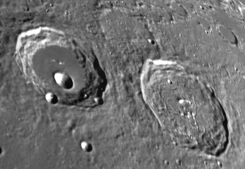
You see the same phenomena here on earth at sunset, shadows get longer as the angle of the sunlight grows smaller when the sun begins to set. This light casts long shadows that highlight the shape of the surface highlighting wrinkles so the lighter shades of the highlands appear as rugged mountains.

In the terminator area the low light angle from the sun casts a shadow in sharp relief showing lunar features. Light from the sun strikes the moon at a low angle creating a twilight zone. The “man in the moon” you might think you see is really a pattern of dark areas that appear as two eyes and a nose.Īt a new or half moon explore the terminator line that separates the daylight area from the night so shadows highlight craters and high spots. Between these plains are long narrow channels called rilles formed from cooled lava that sank into the moon’s surface. Many of the moon landings took advantage of these rather than flat areas. Smooth dark areas known as lowland plains are hardened lava called marias. You’ll see gray streaks called a ray system surround some of the larger craters. Notice all its lunar craters are the result of impact from thousands of meteorites. With binoculars explore craters, marias and rilles (see definitions in moon words below) on the lunar surface. Tip: A moon calendar is a good way to see an overview of the cycle of the moon’s phases throughout the year. During these phases the part of the moon that is not illuminated by sunlight still reflects some light called “earthshine”.Ĭlick here for a NASA video showing the Moon Phases.
#Visit the moon atlas full
After the full moon the moon begins its waning cycle back to a new moon. Throughout the cycle, the moon passes from new to full while its visible side grows from a small crescent shape to a full moon. It changes to gibbous with humped sides or three-quarters full followed by a full moon when the sun fully lights the side of the moon that faces earth. It is a half-moon when the sun fully lights the side of the moon that faces earth and appears like a half circle. The first time you focus on the moon you’ll notice that the moon’s phases begin at its first quarter (the moon is waxing) as a new moon and appears in its crescent phase. Tips to learn about the cycle of moon phases Here’s a link to more about the Artemis launch program from The Planetary Society. Soon Artemis will launch in our next phase of moon exploration. The study of the moon has come a long way since 1969 when Neil Armstrong became the first astronaut to step on the surface of the moon saying, “That’s one small step for man, one giant leap for mankind.” Scientists think the moon was created when a huge rock crashed into earth and flew out into space, orbited the earth and slowly gravity caused the pieces collided and formed the moon. There’s a lot to learn about the moon and the moon phases. As the earth’s only natural satellite, the moon has always intrigued us and the more we send satellites into space, the more the moon captures our interest. landings on the moon which many of us remember.

That’s quite a distance for earth’s closest neighbor in the solar system, which is part of the Milky Way galaxy. This matching of apparent visual size is a coincidence.The National Aeronautics and Space Administration (NASA) tells us the moon is an average of 238,855 miles away from earth. This allows the Moon to cover the Sun nearly precisely in total solar eclipse. The Moon's current orbital distance is about thirty times the diameter of Earth, causing it to have an apparent size in the sky almost the same as that of the Sun. The Moon's gravitational influence produces the ocean tides and the slight lengthening of the day. Its prominence in the sky and its regular cycle of phases have, since ancient times, made the Moon an important cultural influence on language, calendars, art, and mythology. Although it can appear a very bright white, its surface is actually dark, with a reflectance just slightly higher than that of worn asphalt. It is the second-brightest regularly visible celestial object in Earth's sky (after the Sun), as measured by illuminance on the surface of Earth. The Moon is in synchronous rotation with Earth, always showing the same face with its near side marked by dark volcanic maria that fill between the bright ancient crustal highlands and the prominent impact craters. Moon 3D Map allows you to view Moon landscape in a new way. Installed Plugin Version: Google Maps JavaScript API


 0 kommentar(er)
0 kommentar(er)
